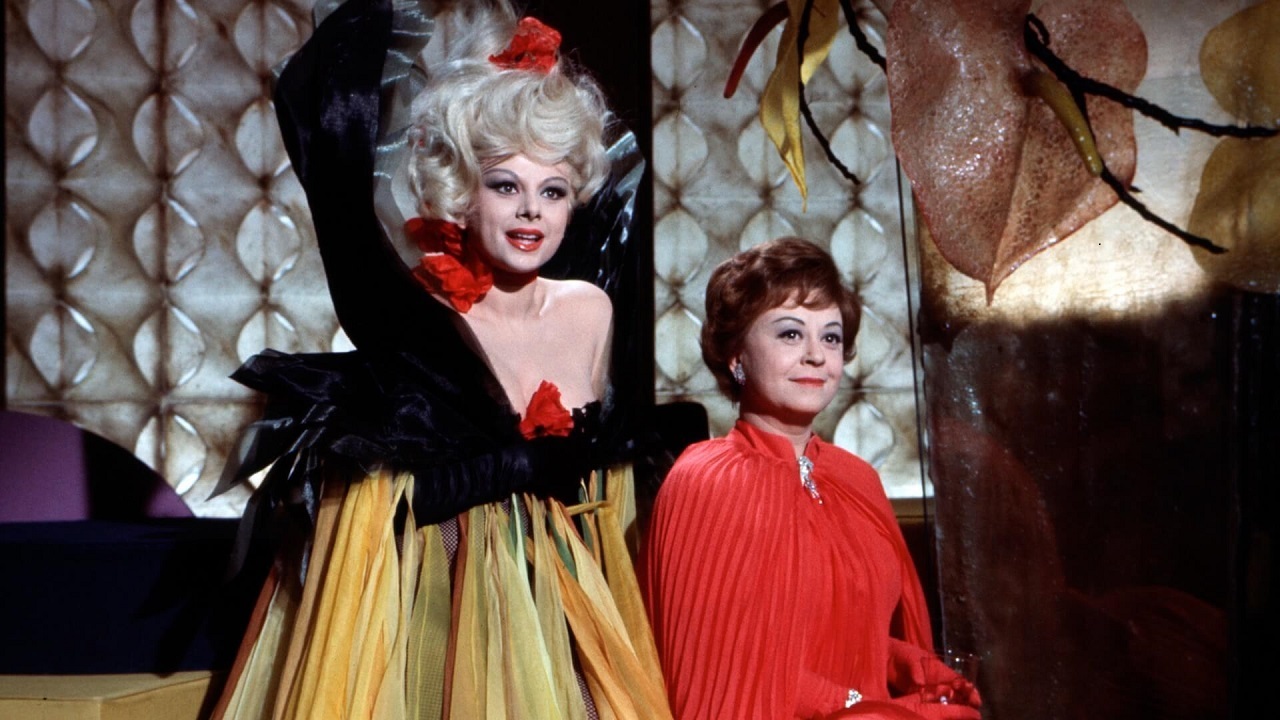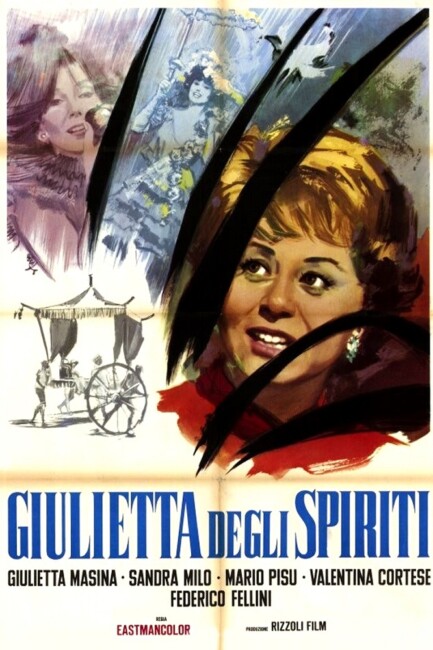(Giulietta Degli Spiriti)
Italy/West Germany/France. 1965.
Crew
Director – Federico Fellini, Screenplay – Federico Fellini, Ennio Flaiano, Tullio Pinelli & Brunetto Rondi, Story – Frederico Fellini & Tullio Pinetti, Photography – Gianni De Venanzo, Music – Nino Rota, Art Direction – Piero Gherardi. Production Company – Eichberg Film GmbH/Federiz/Francoriz Production/Rizzoli Film S.p.a.
Cast
Giulietta Masina (Giulietta), Sandra Milo (Susy), Mario Pisu (Giorgio), Sylva Koscina (Sylva), Valeshka Gert (Bhishima), Valentina Cortese (Valentina)
Plot
Giulietta’s husband Giorgio throws a surprise wedding anniversary party for her. At the party, a psychic holds a séance and one of the spirits she contacts aggressively questions Giulietta. Afterwards, Giulietta tells her doctor that she thinks she is having hallucinations. When she hears Giorgio say the name Gabriela in his sleep, she begins to think he is having an affair. She befriends her neighbour Susy who insists on treating her house like it is a make-believe brothel and the two of them have much fun together. However, the hallucinations increase until people from the present, the past and Susy’s parties begin to crowd in around Giulietta.
Juliet of the Spirits is one of the films from the acclaimed Federico Fellini (1920-93). Although it received much praise during its day, including winning several Best Foreign Language Film awards in its year, its seems to be regarded as a lesser Fellini film today. (A list of Federico Fellini’s other films of genre interest is at the bottom of the page).
Juliet of the Spirits is often called a distaff cousin to Fellini’s 8½ (1963). 8½ was a quasi-surreal autobiographical fantasia with Marcello Mastroianni standing for a creatively frustrated Fellini, around whom Fellini wound in elements from the present and his past. Here Fellini is playing the same autobiographical game that he did in 8½ but with a woman – in fact, casting his real-life wife Giulietta Masina as the central figure.
If anything, rather than 8½, Juliet of the Spirits comes closest to another film that was released the same year as it was – Roman Polanski’s Repulsion (1965). Both films subjectively take place inside the central female character’s mental disintegration and in both cases it is never clear where the dividing line between the real world and fantasy begins and ends.
For all Federico Fellini’s acclaim, Juliet of the Spirits is a difficult film to like. As he became more famous, Fellini began to make his films much more gaudy and indulgent. His films frequently had scripts that consisted only of a single page, with everything else being crafted off-the-cuff on the set by Fellini from somewhere out of the chaos of colour, strange casts and wild costumes that he loved to have circling around him. Here he characteristically directs long scenes and Juliet of the Spirits seems to go on and on without any clear direction being apparent for much of its running time.

You are never sure what all the bursts of surrealism are meant to be about. (This is further hindered by the titles on this print, which were either written in white and placed against a white background or are indistinct and frequently impossible to read). The scenes with the neighbour played by Sandra Milo gradually step over into another of Fellini’s decadent orgies and freakshows, where it becomes apparent that Masina has abandoned reality altogether (although what exactly Sandra Milo’s neighbour is meant to represent here is not clear).
There are some undeniably effective moments – the scene where the psychic becomes possessed, the scene where Giulietta Masina goes to see the woman her husband in involved with and ends up waiting and waiting until dark when the woman fails to turn up. The ending is also worthwhile. Giulietta Masina gives a nicely illuminated performance.
Federico Fellini, although not generally thought of as a fantastic director, did make a number of films of genre interest. These include:– The Temptation of Dr Antonio (1962) wherein a giant Anita Ekberg emerges from a poster and rampages through Rome; the eccentric Toby Damnit segment of the Edgar Allan Poe anthology Tales of Mystery and Imagination/Spirits of the Dead (1968); Fellini’s Casanova (1976), a fantasticised biography of the great lover; and the surreal City of Women (1981). Fellini Satyricon (1969) has been interpreted by one genre purveyor (Peter Nicholls) as a fantasy film, although does not meet the criteria for such in this author’s eyes.
Trailer here


